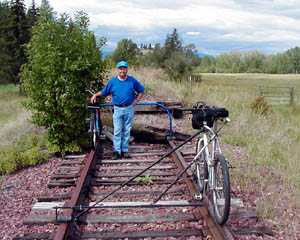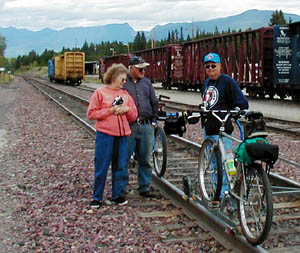
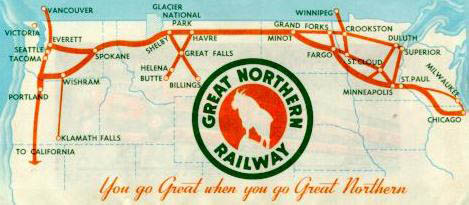
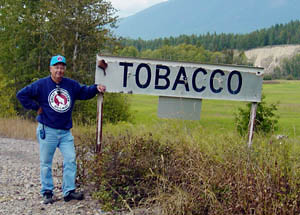
As a young boy, John Vander Ven's mother was a depot operator on the main line between Stryker and Eureka, Montana. John shared his boyhood memories of times and places now relegated to history as we railbiked along the iron pike. His mother's biography, which is a fascinating story of railroad lore, is attached to this article.
The Great Northern Railway
by Peter Hoffman
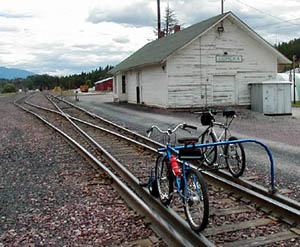
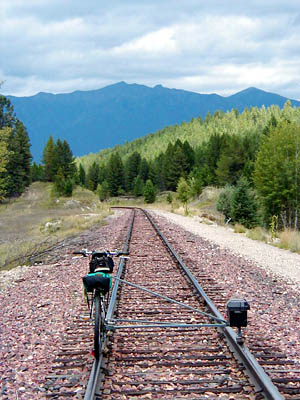
Northwest Odyssey - Part V
At Johns' suggestion we included the segment of the Great Northern Railway between Stryker and Eureka, Montana on our Northwest Odyssey. It was along this section of track that John lived as a boy until he graduated from high school in 1957.
John' mother got her first job as a depot operator in 1943, during the Second World War, in Stryker. For several years while building seniority, she was placed on the "extra board" and had to temporarily fill in for other operators who were sick or on vacation. Thus, John moved often, living in the company houses of agents up and down the line.
In 1950 John's mom, previously divorced, married another depot operator, and they bought a house in Stryker where they were able to share the depot operator shifts. It was while living in Stryker that John first dreamed of rigging his bicycle to ride on the tracks. "There were several side tracks and a 'Y' there," says John, "and whenever a train went into the hole, it would be moving at a very slow rate. I figured it would be perfectly safe. I had a good idea of what I wanted but lacked the expertise and ability to build what I envisioned."
John's mother was stationed at Tobacco for awhile when John was six. Tobacco was no more than a siding with buildings for three operators and their families and far removed from the nearest town, Eureka, five miles to the north. Water was supplied by a well and there was no indoor plumbing. Water had to carried in daily and trips to the outhouse could be unpleasant in the frigid winter months. To get to school, John had to walk three-quarters of a mile out a dirt road to reach the highway, where he was picked up by the bus.
The mainline through Eureka was rerouted
in 1971 when the Libby damn was built on the
Kootenai River. The railroad was forced to build
an 8 mile tunnel to rejoin the disconnected line on
the other side of the mountains. The new main line
turned west at at Stryker, leaving Eureka stranded
at the end of what became a branch line. Today, the
only traffic on the line is produced by one lumber
mill in Eureka. Currently, there is only enough traffic
for a single train a day during the week.
Our Odyssey group had split up on leaving the
Camas Prairie in mid-afternoon the previous day.
We drove independently to meet again in Eureka,
360 miles to the north. Overnighting in various
locations we had varied and interesting experiences
along the way. I was traveling with John and we
were anxious to get to Stryker and see his old
homestead. The house, located close to the tracks
where the old depot used to stand, was unoccupied,
open and forlorn, its only recent visitor an
occasional transient. Owned still by John's brother,
the family plans to renovate it as a vacation cabin.
John and I headed up the line to Eureka to scout
the railroad and to determine, if indeed, no trains
were running that weekend. We wanted to have this
information before the rest of the group arrived.
In Stryker we pulled into lumber mill and John went to the office to ask about the train schedules. After a few minutes he came back out accompanied by a mill employee who happened to be a high school classmate. He was fascinated by our railbikes and went back into the office and soon
The next morning, after staying the night in Eureka, we took our bikes to Stryker in Mike's trailer and railbiked back to Eureka and were we left our cars. The ride from Stryker to Eureka was about 23 miles and mostly flat, with just a short climb at the beginning. Along the way John filled us in on the local history. We stopped for some time in Tobacco and walked the area where the operator's houses used to be. The only evidence of the past were the foundations for the old pump house, and they were totally obscured in the underbrush. It was a nostalgic time for John and we
shared his emotions. I encourage you to read his mother's wonderful autobiography which is attached, just click on the photo of John below.
Heading toward Eureka, riding on what was once the Great Northern's mainline was a special treat.
Two of John's high school friends came out to see John ride by. They had waited over two hours for the rare event, but weren't disappointed.
At the freight station in Stryker
John and I put our bikes on the tracks for a trial run. We were soon joined by the adjoining mill workers and the Mayor who gave us his blessings.
Our group gained another rider when Mark Hamey joined us from Whitehall, Montana But Arne and Morgan left us to ride on another line after deciding the rails were to shiny for their bikes, which have a
tendency to derail if the tracks are not rusted. And shiny there were! Heavy, well maintained, main line
rail that was so unlike are usual fare. A treat of treats after our experience on the Camas Prairie.
When the mainline was re-routed
Eureka became isolated at the
end of a branch line. Here John
poses at the end of the rails
where once the Empire Builder
roared by at 60 MPH.
At the old homestead
came out with several other men, one of which was the manager of the mill as well as being the Mayor of Striker. Everybody loved our bikes, and a couple of the mill workers rode them down the siding and back. The Mayor told us there would be no trains and to go ahead with our plans. Just at that time a Stryker Policeman drove past the tracks. Sensing our concern, the Mayor told us not to worry, the cops couldn't care less and would present no problem.
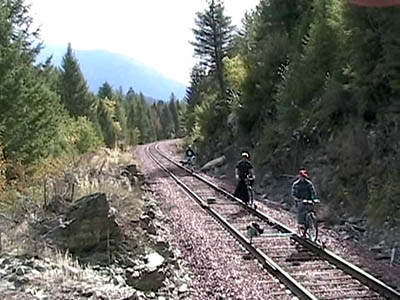
Bear leads Michael and John up the slight grade out of Stryker
